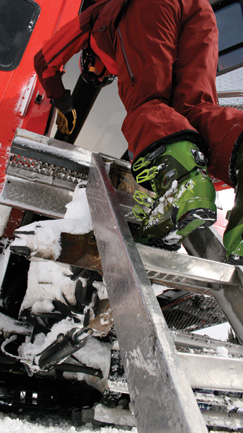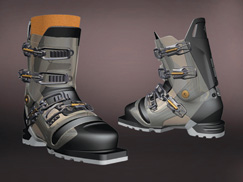Imagine if the hobby you love was actually part of your everyday working life. Well, that is what it’s like for many of the employees at Black Diamond, a Salt Lake City-based manufacturer of climbing and skiing equipment.
“Everybody is a skier or a climber and probably most of us do both,” says Ben Walker, director of R&D at Black Diamond. “It’s a pretty critical aspect of our entire design team.”
A few years back the company decided to venture into a new area – free ride ski boots. Free ride skiers hike up mountains and then ski down on fresh snow. Often, not being able to find the right boots to perform both functions of climbing and skiing, they would take two pairs with them, wear one and carry the other in their backpack.
The challenge for Black Diamond was to create one boot that had the functionality, performance and fit for both purposes. “It was a fairly logical decision to go into free ride boots because we already do skis and bindings, poles and avalanche safety equipment so to add the last big piece of skiers’ equipment to the collection just made sense,” explains Walker.
Team building
Walker manages Black Diamond’s design team, which consists of six mechanical engineering designers and four industrial designers. As many projects are worked on simultaneously this team is then divided into smaller teams for each project.
“The free ride boot project had a team of two mechanical engineering designers and two industrial designers for the first part of the process and then one each after that,” says Walker.
Additionally, each project team consists of quality assurance engineers and product developers, who work as a liaison between the designers and the factory. “Also occasionally we bring in people from our supply chain group to help with the logistics of a project,” says Walker.
The design process at Black Diamond is fairly traditional. “We start out doing a lot of conceptualisation, hand sketches and very rough, cobbled together prototypes to try out ideas,” explains Walker. “We also try to get some testing in on those to make sure that the idea is legitimate and valid.”
Once a concept is chosen, the design team will then bring their ideas into CAD. Black Diamond uses the Siemens NX digital product development system in the creation of all its products.
The six mechanical engineering designers use Siemens NX with one of the industrial designers using NX and the other three using Alias for Class A surfacing. “NX allows us to go from Class A surfaces all the way through to first prototypes and manufacturing,” describes Walker.
Concurrent design
The engineers and designers work collaboratively from the very start of any project.
“Our products are a little bit unique in that, with consumer electronics or automobiles for instance, there is a lot of engineering on the inside and then a nice shell that covers it all up,” says Walker.
“Our products, of which the free ride boot is a good example, the same parts that need to be strong and provide the performance characteristics are also the parts you look at. So engineering and industrial design really need to be incorporated into the same parts.”
NX allows the various team members to work on the boot design simultaneously. An industrial designer could be working on the outside surfaces, whilst an engineer focuses on the foot shape or on the cutter for the buckles.
“We have developed some fairly unique processes where using some of the tools in NX we are able to pass files back and forth between Alias and NX without losing history. We are also able to continually update and modify them on both the engineering and industrial design side,” says Walker.
For Walker, the one NX tool that is particularly useful is NX ShapeStudio with its powerful surfacing features. The same geometry created by the designers in NX Shape Studio is then used by the engineers to analyse the boot’s performance and to design injection moulded parts. The engineers will then carry out a number of simulations on the parts. For instance, the NX Nastran Computer Aided Engineering (CAE) tool is used to carry out a great deal of Finite Element Analysis (FEA).
The analysis results generated from this and other NX simulation tools are often very similar to the real life results, but it takes experience to achieve this.
“The tricky thing with any sort of analysis done in a computer is the analysis is only as good as the inputs you put into it,” says Walker. “That is always the challenge – finding a way to set up the boundary conditions that are really reflective of how that product will be used in the field.
“But as we have enough experience of skis, boots, bindings and all of the other products, both as users as well as designers, we generally have pretty good success with our analysis giving us results that are indicative of how it will perform in the field,” he adds.
Let’s get physical
Although the team makes fewer physical prototypes as a result of using CAE software, they still rely on them no matter how accurate the analysis is.
“The way we look at analysis is that it allows our design iterations to move us closer to the final result but in the end, since the products we build are really used in (not to sound too melodramatic) life or death situations, if something we build fails it really can be pretty catastrophic,” comments Walker.
“I don’t think it would be legitimate for us just to use analysis – we really need to ensure that the products we build are being built in a way that won’t fail.”
Each prototype, both those built early on in the design process as well as production parts, are very vigorously tested in the Lab as well as in the field. “The simulation tools are a nice part of the design process but once we get to actual prototypes or parts off tooling then we are always testing these in our Quality Assurance Lab,” comments Walker.
“We had some custom-built machines specifically for the boot project that are able to test both performance characteristics like the boot flex as well as strength, fatigue, properties of the different materials and mechanisms. These tests were done at both cold temperatures as well as room temperature to simulate all the different environments that the boot could be used in,” he adds.
Having a field day
The designers and engineers do a lot of the field testing themselves. “Our office is only about 20 minutes away from world class skiing so it’s not at all unusual to build some sort of prototype or aspect of the boot that we want to test and then go out in the afternoon and ski for a couple of hours,” says Walker.
So, does he call this work? “Occasionally,” he laughs.
The design team in Salt Lake City will then work with their colleagues at the office in China on the final design and manufacture of the boot. CAD files are shared between the two and any final tweaks can be easily made.
“Our designers and product developers spend a lot of time working directly with the factory to ensure that their processes match the way that we want them to be processed,” says Walker.
After being in development for two to three years, the free ride boot has successfully been launched. “It’s been a great success for us – a very good boot and in many ways it’s defined, I guess, a segment of the market that was not being very well addressed by ski boot manufacturers in the past,” says Walker.
“Being the manager of the design team it’s easy to say that the success all came from the design of a great product. From that perspective the CAD tools that we use, the expertise of the team, the way we work together – all those are really keys to the success,” he concludes.
www.blackdiamondequipment.com
Black Diamond talk about designing all condition mountain gear and fancy footwear










